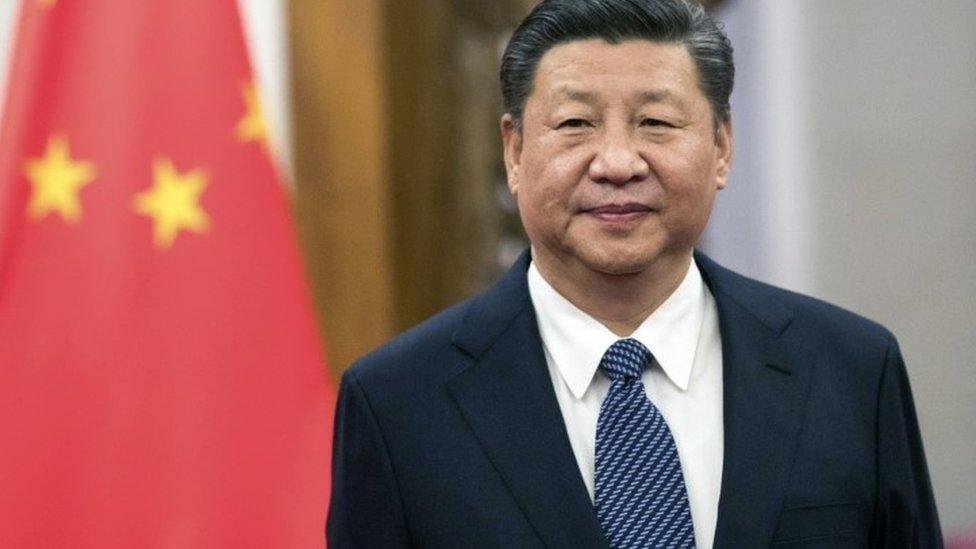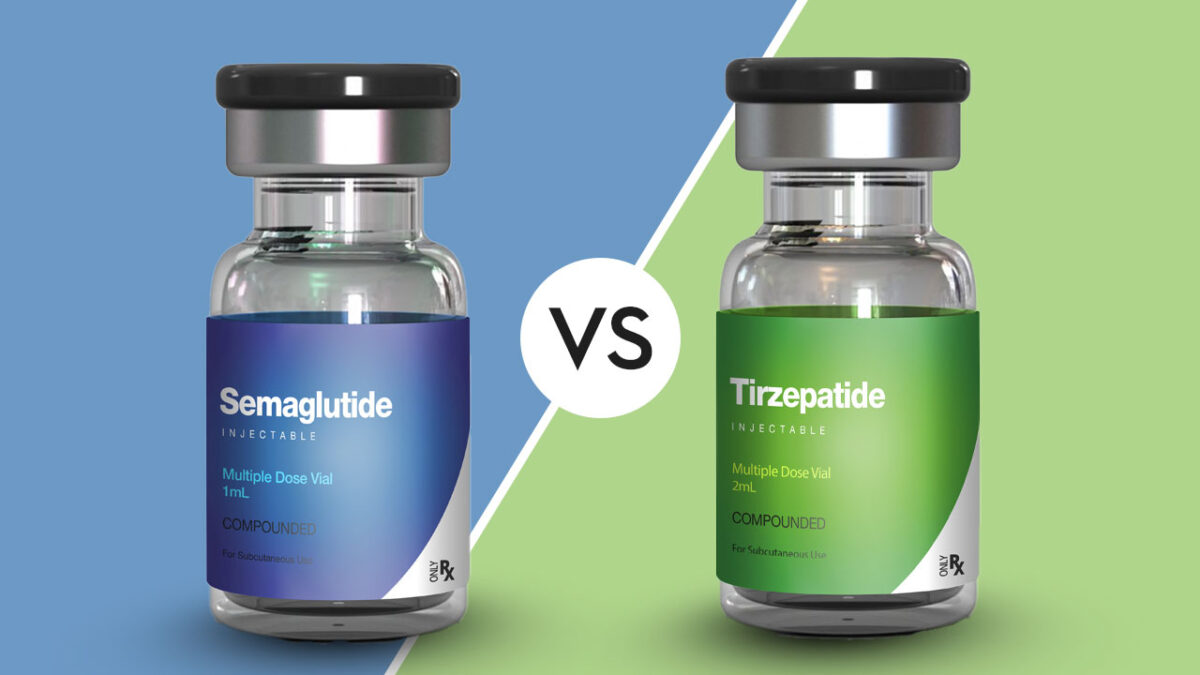- Courses
- GS Full Course 1 Year
- GS Full Course 2 Year
- GS Full Course 3 Year
- GS Full Course Till Selection
- Answer Alpha: Mains 2025 Mentorship
- MEP (Mains Enrichment Programme) Data, Facts
- Essay Target – 150+ Marks
- Online Program
- GS Recorded Course
- Polity
- Geography
- Economy
- Ancient, Medieval and Art & Culture AMAC
- Modern India, Post Independence & World History
- Environment
- Governance
- Science & Technology
- International Relations and Internal Security
- Disaster Management
- Ethics
- NCERT Current Affairs
- Indian Society and Social Issue
- NCERT- Science and Technology
- NCERT - Geography
- NCERT - Ancient History
- NCERT- World History
- NCERT Modern History
- CSAT
- 5 LAYERED ARJUNA Mentorship
- Public Administration Optional
- ABOUT US
- OUR TOPPERS
- TEST SERIES
- FREE STUDY MATERIAL
- VIDEOS
- CONTACT US
WHO Report on Suicide Rate in India
WHO Report on Suicide Rate in India
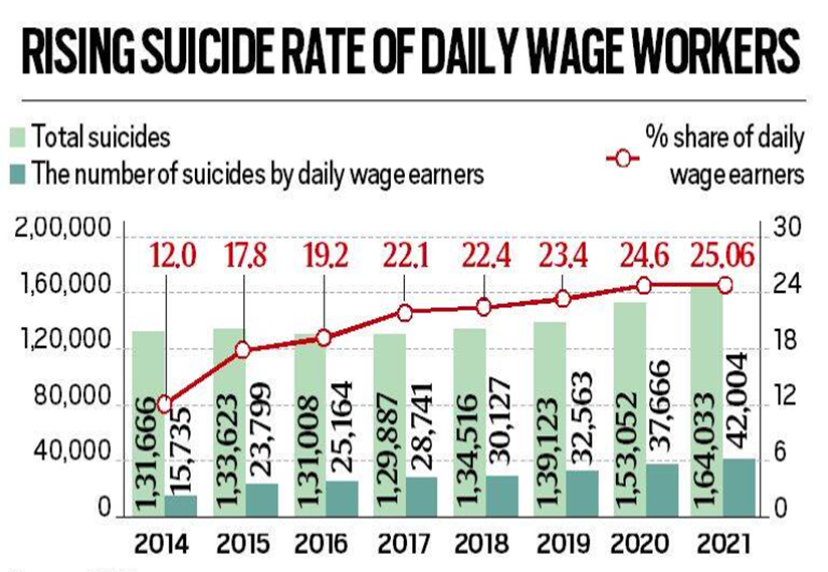
Why in News?
As per World Health Organisation, India’s suicide rate is at 12.9/1,00,000 and is higher than the regional average of 10.2 and the global average of 9.0.
About the Status of Suicides in India
1. In India, every year more than 1 lakh people lost their lives due to suicide, and it is the top killer in the 15-29 years category.
2. From 2019-22, the suicide rate has increased from 10.2 to almost 12.9 per 1,00,000 population.
3. National Crime Records Bureau (NCRB) has recently released report of “Accidental Deaths & Suicides in India Report 2022”. It provides the category wise records as follows:
A) Daily Wagers: Daily wage earners remained the largest profession-wise group among suicide victims in 2021, accounting for 42,004 suicides (25.6%).
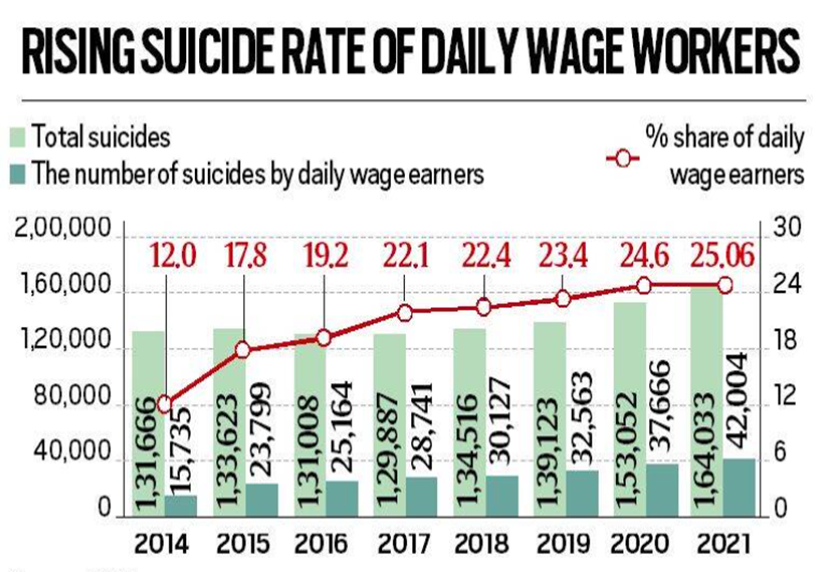
B) Farming Sector: The overall share of “Persons engaged in farming sector” among the total recorded suicides stood at 6.6% during 2021.
C) Profession Wise Distribution:
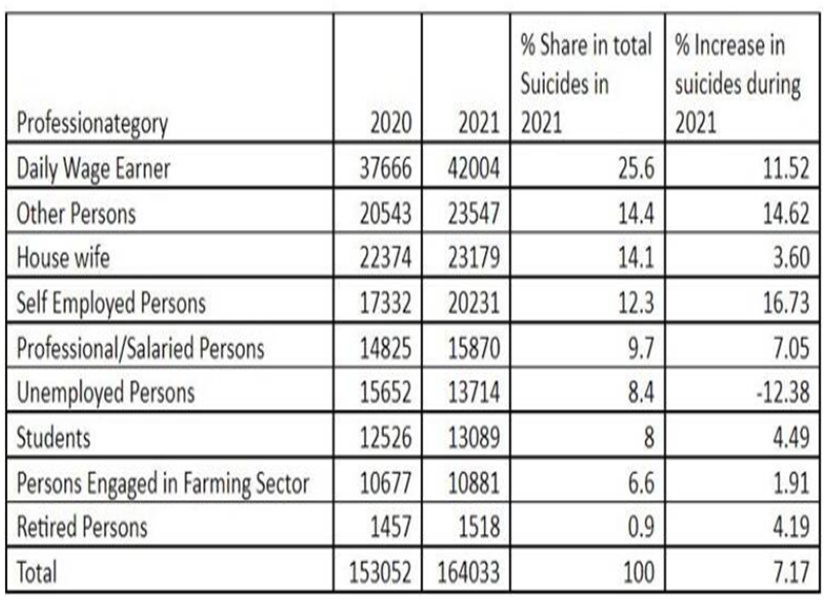
- The highest increase of 16.7% was recorded by “self-employed persons”.
- The “unemployed persons” group was the only one that saw a decline in suicides, with the number dipping by 12.38% from 15,652 in 2020 to 13,714 suicides in 2021.
D) Biggest Reasons for Suicide:
-
- 33%: Family Problems (other than marriage related problems)
- 5%: Marriage Related Problems
- 19%: Illness
4. State-Wise Data:
A) Maharashtra topped the country in terms of the number of suicides reported in 2021 followed by Tamil Nadu and Madhya Pradesh.
B) Maharashtra contributed almost 13.5% to the total number of suicides registered across the country in 2021.
5. Union Territories: Delhi recorded the highest number of suicides in the UT category.
6. Recently, the Ministry of Health and Family Welfare, Government of India has announced the “National Suicide Prevention Strategy”.
About the National Suicide Prevention Strategy
1.It is the 1st of its kind initiative in the country, with time-bound action plans and multi-sectoral collaborations to achieve reduction in suicide related mortality by almost 10% by 2030.
2.This strategy was formed by keeping in mind the World Health Organisation’s ‘South East-Asia Regional Strategy for Suicide Prevention’.
3.The strategy broadly focuses on establishing effective surveillance mechanisms for suicide within the next 3 years.
4.It seeks to establish ‘Psychiatric Outpatient Departments’ that will provide suicide prevention services through the District Mental Health Programme in all districts within the next 5 years.
5.It also aims to integrate a mental well-being curriculum in all educational institutions within the next 8 years.
6.It also aims to develop guidelines for responsible media reporting of suicides, and restricting access to means of suicide.
What is Mental Health?
1. It is a state of well-being in which the individual realizes his /her own abilities, can manage the normal stresses of life, can work productively and fruitfully, and is able to make a contribution to his/her community.
2. Like Physical health, mental health is also important at every stage of life, from childhood and adolescence through adulthood.
Challenges related to Mental Health are:
1. High Public Health Burden: According to the National Mental Health Survey 2015-16, an estimated 150 million Indians need mental health care interventions.
2. Lack of Resources: Psychiatrists (0.3), nurses (0.12), psychologists (0.07), and social workers account for a small proportion of India's mental health workforce (per 100,000 people) is 0.07.
3. Low Health Budget: A low financial resource allocation for health coverage of just over 1% of GDP has created barriers to public access to affordable mental healthcare.
4. Lack of Awareness: Poor awareness about the symptoms of mental illness, social stigma and isolation of mentally ill, especially old and destitute, leads to social isolation and reluctance on part of family members to seek treatment for the patient.
Steps Taken by the Government for Promoting Mental Health are:
1. Constitutional Provision: The Supreme Court has held that healthcare is a fundamental right under Article 21 of the Constitution.
2. NMHP (National Mental Health Program): Since 1982, the government has been implementing the National Mental Health Program (NMHP) to address the enormous burden of mental disorders and the shortage of qualified professionals in the field of mental health.
3. The Program was restructured in 2003 to include 2 schemes: Modernization of state mental hospitals and Enhancement of psychiatric wings in medical colleges/general hospitals.
4. The Mental HealthCare Act 2017: It ensures that every affected person has access to mental healthcare and treatment from government-run or funded services. It has significantly limited the application of Section 309 IPC and made suicide attempts punishable only as an exception.
5. Kiran Helpline: In 2020, the Ministry of Social Justice and Empowerment launched a 24-hour toll-free helpline called 'Kiran' to help people suffering from anxiety, stress, depression, suicidal ideation, and other mental health issues.
6. Manodarpan: It was launched by the Ministry of Human Resources Development (MHRD) as part of the Atmanirbhar Bharat Abhiyan. Its goal is to provide students, family members, and teachers with psychosocial support for their mental health and well-being during Covid-19.
Conclusion and Way Forward
1. We must educate and sensitize the community/society in order to reduce the stigma associated with mental health.
2. When it comes to providing the right care to patients with mental illnesses, we need mental health care intervention for patients as well as innovative models to deepen the penetration of services and staff.
3. One such model is the Ministry of Health and Family Welfare's Accredited Social Health Activist (ASHA).
4. To educate and raise awareness about mental health and the chronic issues that surround it, India requires a huge flow of funds.
5. The public needs can be educated about mental health through campaigns like the ‘Swachh Mansikta Abhiyan’.
Must Check: Best IAS Coaching Centre In Delhi


